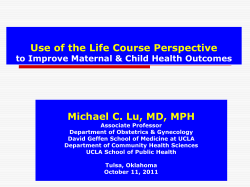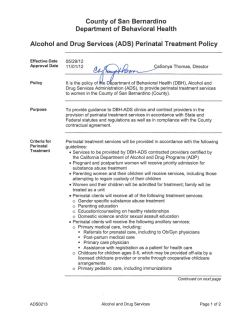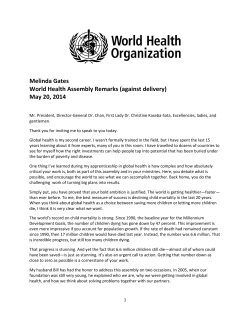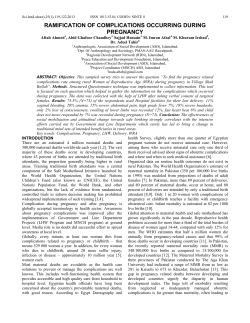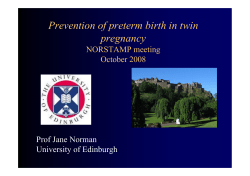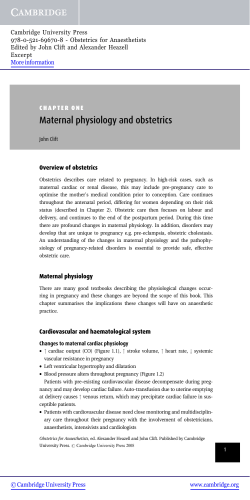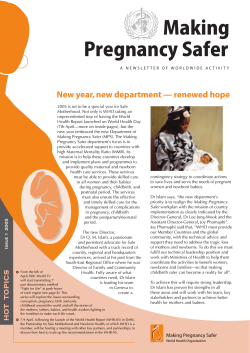
1 1 Is sues in Pregnancy Ca re and
Issues in Pregnancy Care 11 Perinatal and Women’s Health Issue Summary Pregnancy is a critical event in the life of a woman that shapes her relationships with her partner and family, her role in the workforce, and also affects her health. Close to four million births occur annually in the United States, along with an estimated 60 percent or more additional pregnancies to women that end in spontaneous losses, stillbirths, or induced abortions.1 Over ninety percent of women aged 15-44 responding in the 1995 National Survey of Family Growth reported expecting to give birth at least once during their lifetime.2 Indicators of Maternal Morbidity and Mortality Increasingly, attention has been given to measuring morbidity and mortality related to pregnancy and improving the reporting of these incidents. Frequently reported maternal medical complications during pregnancy are pregnancyinduced hypertension (3.6 percent of women), diabetes (2.6 percent), anemia (2.0 percent), and chronic hypertension (0.7 percent).3 The completeness of reporting of maternal medical complications has improved since the introduction in 1989 of a checklist of 16 complications of pregnancy on the standard recommended birth certificate. The prevalence, however, is still underreported.4 Antenatal Hospitalization and Bed Rest. Antenatal hospitalization and bed rest are proxy measures of the morbidity of women during pregnancy. Each year, between 12 and 27 percent of all deliveries in the United States are preceded by an antenatal hospitalization.5-8 History of medical or obstetric problems and lack of prenatal care are associated with antenatal hospitalization.6,9 The most common immediate cause is preterm labor, followed by hypertension, diabetes, bleeding/placenta previa, and premature rupture of the membranes.6,7 Studies examining a possible racial disparity in risk of antenatal hospitalization show conflicting results.5,6,8,9 Bed rest is prescribed in close to 20 percent of all U.S. pregnancies10 and is recommended prophylactically to reduce the risk of several adverse conditions and pregnancy outcomes, including spontaneous abortion, preterm labor, fetal growth retardation, edema, chronic hypertension, and preeclampsia.11-13 Although bed rest is widely recommended, it can have significant detrimental effects on women, including lost wages, disruptions in daily living, and increased levels of stress.14 Maternal Mortality. Maternal mortality is considered a benchmark of the health of a community.15 The magnitude of maternal mortality is in question, however, based on the manner in which data are compiled from vital statistics. It is estimated that the number of pregnancy-related deaths is 1.3 to 3 times that reported in vital statistics data.16 The pregnancyrelated mortality ratio increased from 7.2 in 1987 to 10 in 1990, and the rate of increase was greatest for Black women.17 Racial disparities exist for every cause of maternal mortality, including hemorrhage, embolism, hypertensive disorders, infection, cardiomyopathy, and anesthesia.18 Risk of maternal mortality is also higher for unmarried women, women with low levels of education, women with inadequate prenatal care, and women with higher order multiple pregnancies.18 Low Birthweight and Preterm Delivery. The health care needs of the newborn also offer insight into maternal health and the quality of care during pregnancy. Low birthweight (LBW) infants account for over 7 percent of all U.S. births.3 This percentage has increased in recent years for White women, but has dropped for Black women. The change in LBW among White women is believed to be related to increases in the number of women with multiple pregnancies, which is more common among women who receive treatment for infertility or who delay childbearing.3 LBW has a multi-factorial etiology, associated with: • medical risk factors, such as nulliparity and parity greater than 4, chronic diseases, previous LBW infant, genetic factors, multiple pregnancy, poor weight gain, infection, placental problems, premature rupture of membranes, and fetal anomalies; • demographic risk markers, such as age less than 17 and over 34, African-American race, low socioeconomic statu s ,u n m a rried status, and low level of education; and • behavioral risk factors, such as smoking, poor nutrition, toxic exposures,unintended pregnancy, inadequate prenatal care ,i llicit substance use, and stress.19 The primary cause of LBW is preterm birth, which occurs in 11 percent of deliveries.3 Because the etiology of preterm delivery is largely unknown,20 progress in reducing the rate of early births has been slow. Preterm infants are at increased risk for infant mortality; nearly 70 percent of all neonatal deaths can be attributed to preterm birth. Preterm infants (especially very preterm infants) who survive are at increased risk for developmental delays and a variety of chronic conditions.21,22 Research on the etiology of preterm labor must address the social as well as biological determinants of preterm birth, with special emphasis on modifiable risk factors. Moreover, future research needs to address the many potential reasons, both social and medical, for continued racial differences in preterm births. Preconception and Pregnancy Care Services Preconception care, which emphasizes the need to view women’s health as a continuum, has been promoted as one strategy to assure the health of the mother prior to becoming pregnant.23 It encompasses the identification and management of both chronic (e.g., diabetes) and acute (e.g., reproductive tract infections) medical conditions that may negatively affect prenatal health and pregnancy outcomes; health education and promotion; nutritional counseling; and identification of women with unhealthy behaviors, such as smoking or substance abuse problems, and referral to care. These services are focused on mitigating or preventing insults to fetal development, in some cases often before a woman realizes she is pregnant.24 There are no reliable data on the extent to which women receive preconception care, but it is believed to be infrequent and most likely obtained by women with chronic diseases or by healthy, health-conscious women. Early use of prenatal care has increased in recent years among U.S. women, rising from 76 percent in 1991 to 82 percent in 1996. 3 Although African-American and Hispanic women continue to start care later and get less care, the rise in early use of care in 1996 was greatest for them.3 There is consistent evidence from a number of quasi-experimental studies that provision of comprehensive prenatal care is associated with reductions in LBW rates.25-29 This care includes not only the medical components of prenatal care, but also ancillary services, such as social and nutrition services, health education, and outreach and home visiting, as needed. The effect of particular components of prenatal care on pregnancy outcomes, however, needs to be addressed in future research. Estimates of costs associated with antenatal hospitalizations should be included in studies of the cost-effectiveness of prenatal care. Early Discharge of Mothers and Newborns The length of maternal postpartum hospitalization and the nursery stay of the baby has declined over the past decade due, in part, to changes in medical practice, reimbursement, and patient preferences. Shortages of hospital beds and a trend toward demedicalizing childbirth also have contributed to early discharge practices.30,31 Although early discharge may benefit maternal-infant bonding, it may negatively affect maternal well-being due to the reduced period of rest and to possible lack of confidence about infant care. The increased medical needs in the days after birth (e.g., neonatal jaundice, maternal infection, breakdown of episiotomy), completeness of newborn metabolic screening practices, and the reduction in time for in-hospital teaching and support (particularly in relation to breastfeeding) also raise concerns about the effects of early discharge.32-35 Despite these concerns, no consensus on the maternal and newborn consequences of early discharge exists.32,36-39 Technological Advances In the past few decade s ,m edical advances have been made in prenatal diagnosis, assisted reproductive technologies, prediction of preterm delivery, and extension of newborn viability. The effectiveness of prenatal diagnosis in identifying fetal chromosomal and structural abnormalities has greatly improved. Some of these technologies include: the Triple Marker Screen, used to identify neural tube defects and Down Syndrome40 and chorionic villus sampling (CVS) and amniocentesis, both performed to detect chromosomal abnormalities. Infertility treatment includes Gamete Intra-fallopian Transfer (GIFT) to address abnormalities in the number or motility of the male sperm and Intracytoplasmic Sperm Injection (ISCI), laboratory fertilization and subsequent placement of the embryo in the uterine cavity. New tocolytic therapies have been used to prolong pregnancy complicated by preterm labor, but they have not been demonstrated to significantly affect the absolute number of preterm deliveries.41 The costs of infertility technology bring new dilemmas about (1) health insurance coverage requirements, (2) equal access to this technology by all groups of women, regardless of race and insurance status, and (3) the potential consequences for newborns who require high-cost, long-term outpatient care and special education. For example, fertility treatments may lead to increases in multiple births, which, in tu rn ,i n c reases the risk for compromised birth outcomes. In 1996, 16 percent of neonatal deaths nationally were to multiple births; they were 7 times more likely to die in the first month of life than singleton births.42 The development and availability of improved therapies in neonatal intensive care, which primarily serves very low birthweight (VLBW) infants (less than 1500 grams) and normal weight newborns with life-threatening complications, are believed to be largely responsible for the dramatic decline in infant mortality rates in the last 30 years. In particular, neonatal mortality rates have declined markedly during this time period for the very smallest newborns. Quality of Care Along with advances in medical technologi e s ,t h ere has been increasing national debate about the quality of health care services and guidelines for clinical care. A long history of established clinical guidelines for prenatal care exists. The American College of Obstetricians and Gynecologists (ACOG) Committee on Obstetric Practice and the American Academy of Pediatrics (AAP) Committee on Fetus and Newborn (1997) have collaborated in publication of Guidelines for Perinatal Care. These guidelines are comprehensive and represent the orientation of a variety of disciplines within the perinatal health care system. They also stress flexibility in their implementation to address local population characteristics, resources and the environment for providing care.43 Despite these AAP/ACOG guidelines, the provision of and access to perinatal services has been found to vary by maternal characteristics, with minority and low income women generally receiving fewer services. The quality of ambulatory prenatal care and the use of procedures such as amniocentesis and ultrasound or therapies such as corticosteroids have been shown to differ significantly by socioeconomic status and race/ethnicity.44-46 Lack of implementation of clinical guidelines may lead to unnecessary hospitalizations and additional health care costs.9 Research is needed to assess providers’ implementation of clinical guidelines for prenatal care, to determine the extent to which patient preferences as well as provider non-compliance may influence the content of care, and to identify areas of patient management that are affected by provider uncertainty regarding efficacy and long-term side effects. Organization and Financing of Pregnancy Care Major changes have occurred over the past decade in the organization and delivery of pregnancy care servi ce s ,p a rticularly with regard to financing, with parallel efforts to expand insurance coverage for pregnant women and to reduce costs within the overall health care system through managed care strategies. In the late 1980s, the Medicaid program was expanded for pregnant women and their newborns largely in three areas: broadening the eligible population; simplifying and shortening the eligibility process; and enhancing services provided to pro- gram beneficiaries (e.g., covering nutrition and case management services). The percentage of women with no health insurance at the start of pregnancy dropped from 26 percent in 1985, before the Medicaid expansions, to 19 percent in 1994.2,47 Recent national legislative initiatives regarding health insurance are likely to both positively and negatively affect the affordability of and access to perinatal care by women. The Health Insurance Portability and Accountability Act of 1996 provided new insurance protection for individuals who move from one job to another, who are self-employed, or who have pre-existing conditions. The provisions, which prohibit denial of benefits to pregnant women and application of pre-existing condition exclusions or waiting periods for newborns or adopted children, increase to some degree women’s flexibility in making decisions about employment while pregnant.48 The Personal Responsibility and Work Opportunity Reconciliation Act of 1996 (PRWORA) eliminated most public benefits for both legal and undocumented immigrants, including Medicaid coverage of prenatal care and delivery services. Concurrent changes in immigration policy compound this situation by creating disincentives for accessing prenatal care. Inadequate prenatal care may lead to increased morbidity in the infants of immigrant women. As a result, the cost savings resulting from the exclusion of immigrant women from Medicaid may be offset by increased costs for neonatal care.49 The delinking of welfare/workforce status from Medicaid has raised serious concerns and stimulated policy initiatives encouraging outreach and collaboration. Title V Maternal and Child Health programs, Community and Migrant Health Centers, and other local and state public health programs seeking to serve this population, however, are facing increased demand at a time when resources and capacity for direct services provision are diminishing. The PRWORA legislation illustrates the need to vigilantly monitor population health status and to institute new processes for system responses to overcome unintended consequences of national policy changes. While the percentage of pregnant women enrolled in managed care plans is unknown, enrollment of all Medicaid recipients rose nationally from 9.5 percent in 1991 to 47.8 percent in 1997.50 The growth of managed care may have both positive and negative impacts on pregnancy care. While managed care organizations (MCOs) are traditionally oriented towards providing comprehensive, cost-effective care and coordination of services,51 there is also concern about limited choice of providers, limited physician-patient interaction, limited access to specialist care, and discontinuities in providers due to MCO contracting practices.52 The development of public-private partnerships in communities may be an important strategy for ensuring quality care for women enrolled in managed care plans, while maintaining the presence of population-based services for which public health plays such an important role. Regionalization of Systems for Perinatal Care Regionalization of perinatal care was successful in the 1970s and early 1980s in concentrating VLBW births in tertiary centers, reducing neonatal mortality rates for these infants, and improving overall neonatal mortality rates for the entire population.53 A rise in Level II (specialty), and to a lesser extent selfdesignated Level III (subspecialty) hospitals, is thought, in part, to be a result of competition for perinatal patients. Moreover, the number of neonatologists has increased considerably in recent years, yielding more specialists to staff the newly designated Level II and III facilities.54 These changes have occurred without a concomitant improvement in survival rates for VLBW infants in Level II facilities.55 There also is concern about differential access to high-risk perinatal care dependent upon socioeconomic status. Methods of monitoring and measuring the impact of regional systems of care must be developed and implemented to assure the equitable and cost-effective distribution of resources for pregnant women and newborns. The health services delivery and financing changes in the 1990s highlight the importance of a locus of accountability for the total population, which can be illustrated in perinatal regionalization by the establishment of community boards. These boards are instituted to assure access to care in the community by coordinating services for all pregnant women and newborns residing within a defined geographic area, regardless of income or insurance status, and to assure access to riskappropriate care by instituting procedures for monitoring and surveillance. Studies are needed to evaluate various approaches to establishing a locus of accountability and their effect on access of women to risk-appropriate care and other needed services. Methods for surveillance of maternal mortality and morbidity must improve in order to develop effective interventions, identify high-risk groups, and monitor trends. Efforts to improve the quality of the data must be coupled with a commitment to educate obstetricians, nurse-midwives and family practice doctors about the need to improve the reporting of complications on vital records. Limited understanding of the etiology of preterm labor has hindered attempts to determine what proportion of preterm births may be prevented by obstetric technology, identifying patients likely to experience preterm labor, and actually preventing preterm labor. Further research also is warranted to test adherence of providers to clinical guidelines for prenatal care, to determine the extent to which patient preferences as well as provider non-compliance may influence the content of care, and to identify areas of patient management that are affected by provider uncertainty regarding efficacy and long-term side effects. References 1. 2. 3. 4. 5. Issues for Policy, Practice, and Research* In order to assure the health of pregnant women and their children, steps must be taken to use the information provided herein to determine and implement what works best in the areas of policy, practice, and research. Well-woman care and the provision of family planning services represent opportunities for providers to promote health education and interventions that can affect the health of future pregnancies. A focus on pre-pregnancy health status and access to and utilization of high-quality care for high-risk women may alleviate to some degree the racial disparity in rates of maternal 1 7 ,4 2 mortality. Efforts should be taken to review and implement suggested guidelines for early infant follow-up after discharge, and to develop guidelines related to maternal health status and followup protocols upon discharge. 6. 7. 8. Ventura SJ, Taffel SM, Mosher WD, Wilson JB, Henshaw S, 1995. Trends in pregnancies and pregnancy rates: Estimates for the United States, 1980-92. Monthly Vital Statistics Report 43(11 S): 1-24. Abma JC, Chandra A, Mosher WD, 1997. Fertility, family planning, and women’s health: New data from the 1995 National Survey of Family Growth. Vital Health Statistics 23(19): 1-28. Ventura SJ, Martin JA, Curtin SC, Mathews TJ, 1998. Report of final natality statistics, 1996. Monthly Vital Statistics Report 46(11 S): 1-99. Buescher P, Taylor KP, Davis MH, Bowling JM, 1993. The quality of the new birth certificate data: a validation study in North Carolina. American Journal of Public Health 83(8): 1163-5. Bennett T, Kotelchuck M, Cox CE, Tucker MJ, Nadeau DA ,1 9 9 8 . Pregnancy-associated hospitalizations in the United States in 1991 and 1992: A comprehensie view of maternal morbidity. American Journal of Obstetrics and Gynecology 178: 346 - 354. Franks AL, Kendrick JS, Olson DR, Atrash HK, Saftlas AF, Moien M, 1992. Hospitalization for pregnancy complications, United States, 1986 and 1987. American Journal of Obstetrics and Gynecology 166(5): 1339-1344. Scott CL, Chavez GF, Atrash HK, Taylor DJ, Shah RS, Rowley D, 1997. Hospitalizations for severe complications of pregnancy, 1987-1992. Obstetrics and Gynecology 90(2): 225-229. Adams M, Harlass F, Sarno A, Read J, Rawlings J, 1994. Antenatal hospitalization among enlisted servicewomen, 19871990. Obstetrics and Gynecology 84(1): 35-9. *Given the formative nature of our research on this topic, this material does not reflect an exhaustive list of potential issues of concern. Rather, the material below reflects selected preliminary ideas generated to stimulate dialogue and further study. In addition, certain issues may have been intentionally omitted from this section in favor of their incorporation in other materials prepared as part of a broader initiative to review the state of the field of perinatal and women's health. 9. 10. 11. 12. 13. 14. 15. 16. 17. 18. 19. 20. 21. 22. 23. 24. 25. 26. 27. 28. Haas J, Berman S, Goldberg A, Lee L, Cook E, 1996. Prenatal hospitalization and compliance with guidelines for prenatal care. American Journal of Public Health 86(6): 815-9. Goldenberg RL, Cliver SP, Bronstein J, Cutter GR, Andrews WW, Mennemeyer ST, 1994. Bed rest in pregnancy. Obstetrics and Gynecology 84(1): 131-136. Crowther C, Verkuyl D, Ashworth M, Bannerman C, Ashurst H, 1991. The effects of hospitalization for bed rest on duration of gestation, fetal growth and neonatal morbidity in triplet pregnancy. Acta Genet Med Gemellol (Roma) 40(1): 63-8. Lockwood CJ, Senyei AE, Dische MR, Casal D, Shah KD, Thung SN, Jones L, Deligdisch L, Garite TJ, 1991. Fetal fibronectin in cervical and vaginal secretions as a predictor of preterm delivery. New England Journal of Medicine 325: 669-674. Scott J, 1986. Spontaneous abortion. In Danford D, Scott J, eds. Obstetrics and Gynecology. Philadelphia, PA: JB Lippincott,378-386. Maloni J, 1993. Bed rest during pregnancy: Implications for nursing. Journal of Obstetric, Gynecologic, & Neonatal Nursing 22(5): 422-6. Allen M, Chavkin W, Marinoff J, 1991. Ascertainment of maternal deaths in New York City. American Journal of Public Health 81(3): 380-2. 1998. Maternal Mortality–United States, 1982-1996. MMWR 47(34): 705-7. Berg CJ, Atrash HK, Koonin LM, Tucker M, 1996. Pregnancyrelated mortality in the United States,1987-1990. Obstetrics and Gynecology 88(2): 161-167. Koonin LM, MacKay AP, Berg CJ, Atrash HK, Smith JC, 1997. Pregnancy-related mortality surveillance–United States, 19871990. MMWR 46(SS-4): 17-36. Behrman REE, 1995. Low birth weight. The Future of Children 5(1): 4-231. Morrison J, 1990. Preterm birth: A puzzle worth solving. Obstetrics and Gynecology 76(1 Supplement): 5S-12S. McLean M, Walters W, Smith R, 1993. Prediction and early diagnosis of preterm labor: A critical review. Obstetrical and Gynecological Survey 48(4):209-225. Shiono P, Behrman R, 1995. Low birth weight: Analysis and recommendations. Future of Children 5(1): 4-18. U.S. Department of Health and Human Services, 1989. Caring for our future: The content of prenatal care. A report of the Public Health Service Expert Panel on the Content of Prenatal Care. Washington, DC: U.S. Department of Health and Human Services. Jack B, Culpepper L, 1990. Preconception Care. In Merkatz IR, Thompson JE, eds. New Perspectives on Prenatal Care. New York: Elsevier. Korenbrot CC, 1984. Risk reduction in pregnancies of low income women. Mobius 4(3): 35-43. Peoples MD, Grimson RC, Daughtry GL, 1984. Evaluation of the effects of the North Carolina improved pregnancy outcome project: Implications for state-level decision making. American Journal of Public Health 74: 549-554. Buescher PA, Meis PJ, Ernest JM, Moore ML, Michielutte R, Sharp P, 1988. A comparison of women in and out of a Prematurity Prevention Project in a North Carolina perinatal care region. American Journal of Public Health 78: 264-267. Handler A, Rosenberg D, 1992. Improving pregnancy outcomes: Public versus private care for urban, low-income women. Birth 19(3): 123-130. 29. Buescher PA, Ward NI, 1992. A comparison of low birth weight among Medicaid patients of public health departments and other providers of prenatal care in North Carolina and Kentucky. Public Health Reports 107(1): 54-59. 30. Strong Jr T, Brown Jr W, Brown W, Curry C, 1993. Experience with early postcesarean hospital dismissal. Amerian Journal of Obstetrics and Gynecology 169(1): 116-9. 31. Theobald G, 1959. Home on the second day: The Bradford experiment: The combined maternity scheme. British Medical Journal 2: 1364-1367. 32. Braveman P, Egerter S, Pearl M, Marchi K, Miller C, 1995. Problems associated with early discharge of infants. Early discharge of newborns and mothers: A critical review of the literature. Pediatrics 96: 716-726. 33. Levy H, 1995. Is early discharge a problem for newborn screening? In Pass KA, Levy HL, eds. Early Hospital Discharge: Impact on Newborn Screening. Atlanta, GA: The Council of Regional Networks for Genetic Services, Emory University School of Medicine,23-30. 34. Naylor E, 1995. Impact of early hospital discharge on newborn screening for sickle cell disease, homocystinuria and maple syrup urine disease. In Pass KA, Levy HL, eds. Early Hospital Discharge: Impact on Newborn Screening. Atlanta, GA: The Council of Regional Networks for Genetic Services, Emory University School of Medicine,126-132. 35. Panny S, 1995. Problems associated with early discharge experi en ced by the Maryland Newborn Screening Program: Effectiveness and limitations of voluntary repeat screening. In Pass KA, Levy HL, eds. Early Hospital Discharge: Impact on Newborn Screening. Atlanta, GA: The Council of Regional Networks for Genetic Services, Emory University School of Medicine,213-232. 36. Beck C, 1991. Early postpartum discharge programs in the United States: A literature review and critique. Women’s Health 17: 125-138. 37. Britton J, Britton H, Beebe S, 1994. Early discharge of the term newborn: A continued dilemma. Pediatrics 94(3):291-5. 38. Norr K, 1987. Outcomes of postpartum early discharge, 19601986. A comparative review. Birth 14(3): 135-41. 39. American Academy of Pediatrics, 1995. Policy Statement: PostDelivery Care for Mothers and Newborns Act, [ONLINE]. Available: http://www.aap.org/policy/968.html. 40. American College of Obstetricians and Gynecologists (ACOG), 1996. Maternal Serum Screening. ACOG Educational Bulletin 228: 1-9. 41. Goldenberg R, Rouse D, 1998. Prevention of premature birth. New England Journal of Medicine 339(5):313-320. 42. Guyer B, MacDorman MF, Martin JA, Peters KD, Strobino DM, 1998. Annual summary of vital statistics-1997. Pediatrics 102(6):133-1349. 43. American Academy of Pediatrics (AAP), American College of Obstetricians and Gynecologists (ACOG), 1997. Guidelines for Perinatal Care. Washington, DC: American Academy of Pediatrics and the American College of Obstetricians and Gynecologists. 44. Baldwin LM, Raine T, Jenkins LD, Hart GL, Rosenblatt R, 1994. Do providers adhere to ACOG standards? The case of prenatal care. Obstetrics and Gynecology 84(4): 549-556. 45. Bronstein JM, Cliver SP, Goldenberg RL, 1998. Practice variation in the use of interventions in high-risk obstetrics. Health Services Research 32(6): 825-839. 46. Haas J, Udvarhelyi I, Morris C, Epstein A, 1993. The effect of providing health coverage to poor uninsured pregnant women in Massachusetts. JAMA 269(1): 87-91. 47. Horton J, 1995. The Women’s Health Data Book: A Profile of Women’s Health in the United States. Washington DC: Jacobs Institute of Women’s Health. 48. U.S. Department of Labor, 1996. Questions & Answers: Recent Changes in Health Care Law. Washington, DC: U.S. Department of Labor, Pension and Welfare Benefits Administration. 49. Minkoff H, Bauer T, Joyce T, 1997. Welfare reform amd the obstetrical care of immigrants and newborns. New England Journal of Medicine 337: 705-707. 50. Health Care Financing Administration, Data and Systems Group, 1997. National Summary of Medicaid Managed Care Programs and Enrollment, [ONLINE]. Available: http://www.hcfa.gov/medicaid/trends97.htm. 51. Delbanco S, Smith MD, 1995. Reproductive health and managed care: An overview. The Western Journal of Medicine 163(3 supplement): 1-6. 52. Goldfarb N, Hillman A, Eisenberg J, Kelley M, Cohen A, Dellheim M, 1991. Impact of a mandatory Medicaid case management program on prenatal care and birth outcomes. Medical Care 29(1): 64-71. 53. McCormick M, Shapiro S, Starfield B, 1985. The regionalization of perinatal services: Summary of the evaluation of a national demonstration program. JAMA 253(6): 799-804. 54. Phibbs CS, Bronstein JM, Buxton E, Phibbs RH, 1996. The effects of patient volume and level of care at the hospital of birth on neonatal mortality. JAMA 276(13): 1054-1059. 55. Mayfield JA, Rosenblatt RA, Baldwin LM, Chu J, Logerfo JP, 1990. The relation of obstetrical volume and nursery level to perinatal mortality. American Journal of Public Health 80(7): 819-823. Issues in Pregnancy Care 11 Donna M. Strobino, Dawn Misra, Wanda Nicholson, Melissa Hawkins and Charlyn Cassady This summary is based on a paper written by Donna M. Strobino, PhD, Dawn Misra, PhD, Wanda Nicholson, MD, MPH, Melissa Hawkins, MHS and Charlyn Cassady, PhD Development of this summary was supported in part by a Cooperative Agreement (MCU 249386) from the Maternal and Child Health Bureau (Title V, Social Sec u ri ty Act), Health Resources and Servi ce s Administration, Department of Health and Human Services. q Women’s and Children’s Health Policy Center, Johns Hopkins University, 1999 Women’s and Children’s Health Policy Center WCHPC This Issue Summary is one in a set of thirteen, prepared as part of an initiative -- Perinatal and Women's Health: Charting a Course for the Future -- sponsored by the Maternal and Child Health Bureau in partnership with the Women's and Children's Health Policy Center at the Johns Hopkins School of Public Health. The intent of this work is to highlight policy and program areas needing to be addressed to ensure the continuous improvement of health care and services related to perinatal and women's health over the coming decade. Copies of this and the additional Issue Summaries listed below can be accessed by contacting: National Maternal and Child Health Clearinghouse at 703/356-1964. 1 2 3 4 5 6 7 8 9 10 11 12 13 The Social Context of Women's Health Women's Reproductive Health and Their Overall Well-being Women's Experience of Chronic Disease Depression in Women Abuse Against Women by Their Intimate Partners The Nutritional Status and Needs of Women of Reproductive Age Women's Physical Activity in Leisure, Occupational and Daily Living Activities Effects of Drug and Alcohol Use on Perinatal and Women's Health Effects of Smoking on Perinatal and Women's Health Pregnancy Planning and Unintended Pregnancy Issues in PregnancyCare Health Care Services and Systems for Women of Reproductive Age Public Health Roles Promoting the Health and Well-being of Women
© Copyright 2026
